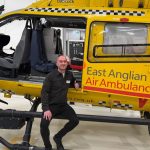6 Dec 2024
Winter considerations for clinical crew
As we head towards Christmas, and big coats and frosty mornings make more appearances, our thoughts turn to the crew’s considerations when the colder weather bites. We caught up with Dr Kate and Critical Care Paramedic (CCP) Rod to hear more about some of the ways the crew and medical equipment adjust to delivering critical care in a variety of environments during the Winter months.
Dr Kate explains that the human body is programmed to operate within a tight temperature range.
“Outside of that range, reactions in the body can’t operate normally,” Dr Kate says. “Hypothermia could result in increased blood loss as the body’s ability to clot effectively is affected, and more oxygen consumption through shivering. It can also increase the rate of infection and risk of cardiac events – so it’s really important that we keep the patients we attend warm while we assess and treat them.”
This can be done in a number of ways. In addition to the advanced equipment and medication, EAAA crews also carry some simple but vital equipment to help keep patients warm. This includes woollen hats, blankets and air-activated heat mats. If a patient is wearing wet clothes, these will be cut off.
CCP Rod says, “We also use Blizzard Blankets. These look like the foil blankets people may have seen Marathon runners use at the end of a race, but these are double layered to insulate and keep patients warm.”
The crew and patients can receive a warming boost if they treat patients in the back of a land ambulance by making sure the heaters are on.
Rod continues, “Protecting patients from the cold is so important. Some of the advanced interventions that EAAA critical care crews carry out at scene, such as anaesthetising very poorly patients, can cause a patient’s body temperature to drop. All year round it’s vital that we keep them warm, and especially so during Winter.”
Rod goes on to explain that they can also administer warmed fluids through a MEQU machine: “It’s a battery-powered fluid warmer for when blood or other fluids are administered intravenously. It will warm the fluids to body temperature.”
It’s not just patients that need protection from the cold weather. Blood gas machines, carried by EAAA crews, require heat pads during the winter.
“The blood gas machine is a diagnostic tool which enables us to perform a blood test at the scene,” Dr Kate says. “It’s a brilliant machine which analyses a patient’s blood oxygen levels, acid levels and electrolytes. However, the machine needs to be kept at an ambient temperature so, in colder weather conditions, heat pads are used and changed every 12 hours.”
The crew also take care to keep themselves warm, as they never know whether they could be called upon to provide enhanced treatment and care in somebody’s home, at a roadside, on the coast or in a field exposed to the elements.
“We make sure we wear layers underneath our flight suits,” Dr Kate says. “And of course, once we’re back at base after treating a patient, we make sure we warm up with plenty of tea and coffee!”







